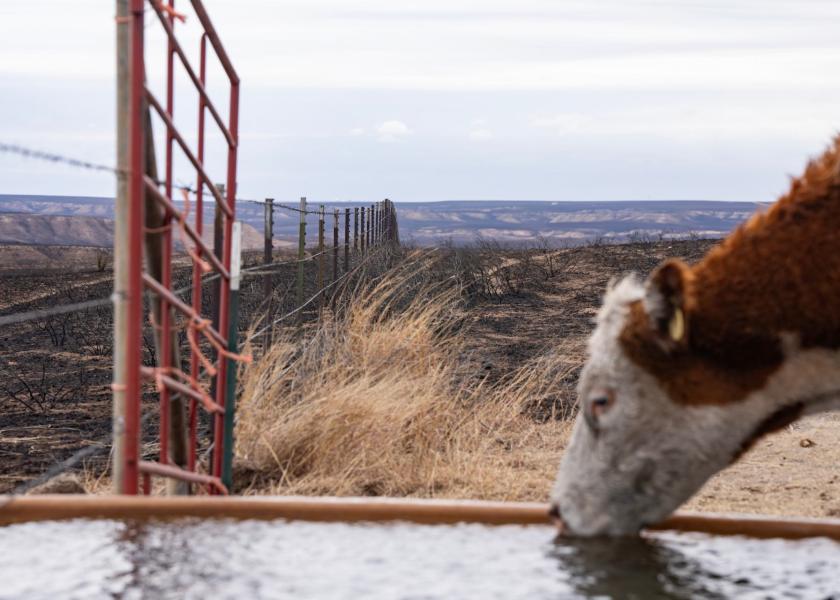Texas Wildfires Impacting Panhandle Ranchers But Not Overall Cattle And Beef Prices

Wildfires in the Texas Panhandle caused significant cattle losses for individual ranchers, but should not impact beef cattle markets or consumers, according to a Texas A&M AgriLife Extension Service expert.
Dr. David Anderson, AgriLife Extension economist in the Texas A&M Department of Agricultural Economics, Bryan-College Station, said it may be weeks before there are estimates for lost cattle, but he expects the impact of the wildfire to be localized.
The Smokehouse Creek Fire that started in Hutchinson County has burned more than 1 million acres across the Texas Panhandle and Oklahoma. The size and scope of the fire along with reports about the Panhandle being home to 85% of the state’s beef cattle herd has led to inferences about large-scale cattle losses.
Much of the state’s cattle herd does move through the Panhandle because the region is a major hub for feedlots where beef cattle are fed grain before being processed. However, beef cow populations are spread throughout the state.
For instance, in 2023 the U.S. Department of Agriculture National Agricultural Statistics Service county-by-county inventory reports showed 17,000 beef cattle in Hemphill County, which was hit hard by the fires. By comparison, at the same time Gonzalez County, east of San Antonio, was home to 54,000 beef cattle.
“I’ve been getting a lot of questions about whether this fire would impact cattle prices and consumers, but the short answer is, no,” Anderson said. “I think some people were under the impression there could be a significant percentage of the Texas herd lost, but that is not the case. It’s devastating if your ranch and your herd is in the disaster area, but it won’t really impact cattle or beef prices because of the numbers and scale of the entire market.”
Counting Losses
Anderson said individual losses could mount very quickly for producers in the fire’s path, especially considering cattle values and the cost of infrastructure like fencing.
Cattle prices continue to trend upward and set all-time records. Anderson expects that trend will continue into 2025 because the U.S. and Texas herd has shrunk over the past two years due to drought.
Cattle values range based on factors like age and class, he said. Cull cows, which are cows aging out of calf production typically weighing around 1,200 pounds, were selling for $1 per pound last week. On the other end, a 500-600 pound calf was selling for more than $3 per pound.
Calf prices continue to set records. Calves in the 500-600-pound range were averaging $2.35 per pound this time last year compared to $3.14 per pound last week.
Spring calving season is underway, which means the wildfire could have erased the value of a productive cow and future value of any calf lost, Anderson said.
“This was a year to make up for a heck of a lot of drought, and the cost of holding on through drought,” he said. “I think there was some optimism with conditions improving and record high prices. It’s just terrible for producers who lost productive cows and potential record prices for spring calves.”
Infrastructure losses will vary for individual producers as well, Anderson said. Damage can range considerably when considering structures, hay stocks, fences and equipment. Fencing alone costs about $3 per foot to replace.
“How many miles of fence are in those 1 million acres that burned?” he asked. “It’s going to be a big number. Then you have the loss of hay and grass for grazing. The impacts of the fires are going to be felt for a while.”
Anderson noted that producers across Texas and in nearby states are shipping hay and other needed supplies to help producers impacted by the fires. AgriLife Extension’s Disaster Assessment Recovery (DAR) unit is coordinating recovery efforts, including intake of material and feed donations in the area. General information about donations or relief efforts can be obtained by calling 806-354-5800. Several Animal Supply Points have been set up where those with hay, feed or fencing materials or with equipment to haul hay can help.
Texas, U.S. Herd Rebuild Still Ahead
Anderson said he hopes producers impacted by the wildfire receive the assistance they need to recover. Rebuilding a herd amid record-high cattle prices will make it difficult.
The beef cattle herd in Texas is the smallest – 4.1 million head – since 2014. The Texas herd started to recover from the 2011-2012 drought after that low point.
The nation’s beef cow herd fell 2% since last year to 28.2 million head, according to the USDA cattle inventory report. Anderson said the report estimate is the lowest number of U.S. beef cows since 1961.
The Texas herd expanded rapidly after the 2011-12 drought, and prices spiked in 2015. But that may not be the case this time because of high prices and lingering drought conditions.
Anderson said he has still not seen definitive signs that producers have begun holding back replacement heifers at rates that suggest widespread rebuilding of the Texas or U.S. herds. Expansion of the state and national herd can take years.
Heifers born this spring would begin producing calves in two years. Calves born to those newly productive cows would not start impacting U.S. beef production until two years after that, or 2028.
“Restocking is difficult when prices are high, and so far we’re looking at slower expansion of the Texas herd,” he said. “Losing animals at a time like this is a terrible blow, but we’re still expecting even higher prices in 2025 and beyond.”







